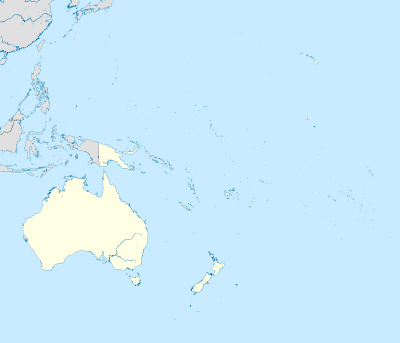Bishop and Clerk Islets
 Bishop and Clerk Islets Location in the Southwestern Pacific Ocean | |
| Geography | |
|---|---|
| Location | Southwestern Pacific Ocean |
| Coordinates | 55°07′S 158°41′E / 55.117°S 158.683°E |
| Area | 60 ha (150 acres) |
| Highest elevation | 45 m (148 ft)[1] |
| Administration | |
| State | Tasmania |
| Demographics | |
| Population | uninhabited |
| Additional information | |
| Type | Natural |
| Criteria | vii, viii |
| Designated | 1997 (21st session) |
| Reference no. | 629 |
| State Party | Australia |
| Region | Asia-Pacific |
The Bishop and Clerk Islets are a 60-hectare (150-acre) group of islets, lying 33 kilometres (21 mi) south of Macquarie Island in the southwestern Pacific Ocean. They are, with Macquarie Island, part of Tasmania, Australia.[2][3] The group consists of Bishop Islet, 24 smaller islets, and various rocks and reefs. Bishop Islet has an area of 3 hectares (7.4 acres) and is mostly rock with some shallow patches of soil. Its highest elevation is 45 metres (148 ft).[1]
The Bishop and Clerk Islets are part of the Australian state of Tasmania. They are the southernmost terrestrial point of both Australia (excluding the Australian Antarctic Territory) and Tasmania. The islets are within the Macquarie Island Nature Reserve, managed by the Tasmanian Parks and Wildlife Service and along with Macquarie Island and the Judge and Clerk Islets,[4] were inscribed in 1997 on the UNESCO World Heritage Area,[5] and form a Special Management Area within the nature reserve.[1] They are very infrequently visited and are free of introduced animals and plants.[6]
History
Three known landings have been made on the islets, all by ship-assisted helicopter. The first, in 1965, was on a rock 50 metres (160 ft) from Bishop Isle. The following two, in 1976 and 1993, were on Bishop Islet itself.[1]
Ecology
Macquarie shags have been recorded nesting at the Bishop and Clerk Islets. A colony of black-browed albatrosses was discovered in 1965.[7]
The only vascular plant recorded on Bishop Islet is Colobanthus muscoides, while two varieties of lichens have also been noted.
See also
References
- 1 2 3 4 Cooper, John. "ACAP Breeding Site No. 66. Bishop and Clerk Islets: Australia's southernmost albatross colony". Retrieved 5 December 2014.
- ↑ Brothers, Nigel; Ledingham, Rod (5 August 2008). "The avifauna of Bishop and Clerk islets and its relationship to nearby Macquarie Island" (PDF). Papers and Proceedings of the Royal Society of Tasmania. 142 (1): 117–121. Retrieved 5 December 2014.
- ↑ "Macquarie Island World Heritage Area". Parks and Wildlife Tasmania.
- ↑ "World Heritage Places - Macquarie Island - Outstanding Universal Value". Department of the Environment. Australian Government. Retrieved 5 December 2014.
- ↑ "Macquarie Island". World Heritage List. UNESCO. 1997. Retrieved 8 July 2016.
- ↑ Parks and Wildlife Service (2006). "Macquarie Island Nature Reserve and World Heritage Area Management Plan" (PDF). Parks and Wildlife Service, Department of Tourism, Arts and the Environment. Hobart: Tasmanian Government. ISBN 978-0724-664-054. Archived from the original (PDF) on 2008-07-21.
- ↑ Alderman, R; Double, M; Valencia, J; Gales, R (2005). "Genetic affinities of newly sampled populations of Wandering and Black-browed Albatross". Emu – Austral Ornithology. 105: 169–179. doi:10.1071/MU04034.